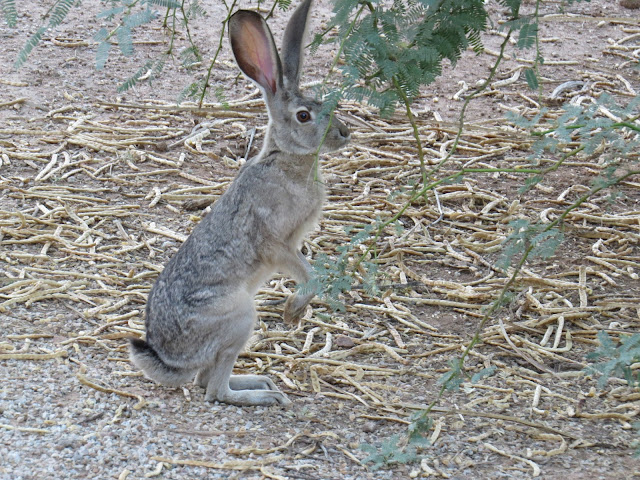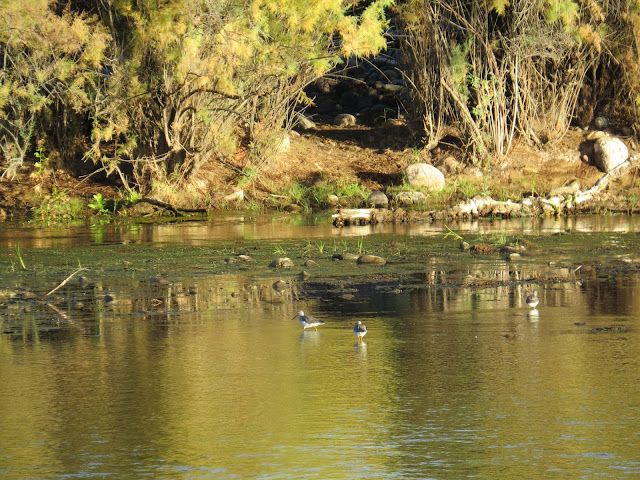It seemed a good day for a trip to Tucson for some birding as several things worked in my favor: cooler temperatures, a few rarities and avoidance of commuter traffic during weekdays.
Additionally, two birder friends who had never been there agreed to join me to see how it compared to our local Gilbert Water Ranch.
Up early again, I met Hinde and Rosemarie at 5 a.m. so that we were able to begin birding at 6:45, shortly after sunrise. Cool temperature of 63°F had us smiling immediately.
The trifecta of rarities we might find included American Bittern, Baltimore Oriole and Black & White Warbler. I was birding the location as thoroughly as possible, not necessary going for each of those birds -- just hoping to see them.
With nothing spectacular awaiting us in the big cottonwood tree at the entrance, we continued westward on the sidewalk. Soon, I heard a Cooper's Hawk calling softly so I started to search the nearby trees. Behind me, Rosemarie looked up and said, "It's right above us!!"
Sure enough! Can you believe it stayed there as long as I took photos from directly beneath it - as close as I've ever been to a Cooper's in the wild.
Shortly after we reached the Gazebo, we had two fly-overs I couldn't believe. One was the BALTIMORE ORIOLE that Rosemarie spotted and that I got on briefly but sufficiently to know what I was seeing. [This past Spring, we had hundreds of them in a fall-out at High Island, TX.] It was flying from the SE to the NW past us, possibly landing within that area of Sweetwater or at the old water treatment plant across Roger Road. This eastern oriole is a continuing bird at this location but sightings are not guaranteed.
From our platform out over a cove of water, I started looking at the ducks but another bird soon came our way. Having never seen this bird in flight before, I was noting its ID markings: bigger than Green Heron; smaller than Great Blue. Brown bird; slow similar wing beats; hunched shoulder posture. I got really excited. Yikes!! Another one of the rarities: AMERICAN BITTERN. It flew from the SE to the NW past us and as soon as I lost it behind trees, I went running to get an even longer better look, but it was gone.
Fortunately, I didn't have to be concerned about whether my call was correct or not as Luke Safford and his son (Tucson Audubon Bird Trip Leader) arrived asking if we had seen it. Yay! Yes, we did.
While focusing again on the pond, another flock of birds flew over going the opposite direction = YELLOW-HEADED BLACKBIRDS! Luke's son (not very old) called its size: 50!
Already, Hinde and Rosemarie were commenting on how differences in layout between Gilbert Water Ranch and these wetlands seemed to provide for more up close and personal sightings.
As we ambled the pathways for the next three hours, we spotted and/or heard a variety of birds: SORA, COMMON GALLINULE (Moorhen), YELLOW-RUMPED WARBLERS, but not the Black & White Warbler, the last of the trifecta.
But there were more raptors: five (5) RED-TAILED HAWKS, a SHARP-SHINNED HAWK, a PEREGRINE FALCON and three (3) more COOPER'S HAWKS, the most cooperative bird for photos there today.
 |
| Cooper's Hawk #2 |
 |
| Cooper's Hawk #3 |
Not knowing how many resident Cooper's Hawks might be present, I checked with local birders there and they said my numbers were good. Can it be the same bird over and over? Not today, anyway, because I heard them calling softly to one another. And, one of the Cooper's flared its white under tail feathers out to the side in a display as it flew, presumably, toward a female.
With temperatures not yet into the 80sF, we decided to drive the short distance west to Christopher Columbus Park where we saw several different birds.
Our first GREAT BLUE HERON of the morning was across the lake.
A gorgeous Western Grebe swam in close enough for a photo op.
And, then, there was a bird that made us work for an ID. Was it leucistic? Was it lighting?
The greatest number of birds in the trees and on the grounds was GREAT-TAILED GRACKLE. This strange looking bird appeared to be one and as it ended up, the whiteness was a trick of lighting.
The western female Great-tailed Grackle is a pale warm brown color underneath; I had just never seen one at that angle in such light. We laughed at having been challenged by such a common bird.
The rarity at this location came swimming right up to us.
 |
| SNOW GOOSE (dark morph) spent the summer on this lake |
 |
| Snow Goose came up on land for a snooze [sometimes called "blue goose"] |
 |
| ...with eyelid closed |
The three of us enjoyed our picnic lunch at the south end of the lake before heading home on local roads heading NE toward Coolidge to avoid the rushing traffic on I-10.
Of course by 1:30 in Apache Junction, the temperature was in the 90s, but we had had a respite from heat and spotted some very nifty birds in the process.
* * *
View this checklist online at http://ebird.org/ebird/view/checklist/S32285883
View this checklist online at http://ebird.org/ebird/view/checklist/S32286241



















































